
Early Bird Offer! Free tickets to meet independent experts at this summer's Build It Live
Save £24 - Book Now!
Early Bird Offer! Free tickets to meet independent experts at this summer's Build It Live
Save £24 - Book Now!Choosing a roof covering, as with most decisions on building materials, needs to be considered early on when planning your self build, renovation or extension project.
Your selection and design will be influenced by a variety of factors, including planning stipulations, your budget, the style of the build and how long you’re planning on living there for.
While concrete roof tiles are undeniably the choice of the mass market, many people opt for clay due to its list of attractive benefits.
Self builders tend to favour craftsmanship, which sometimes tips the balance in favour of clay. But with such a large variety of styles and profiles available in concrete, as well as a more appealing price tag, there’s a good argument for both.
Here are the main differences of both clay and concrete roof tiles to help you make the best decision for your project.
Concrete roof tiles are made from a mixture of water, sand and cement, moulded under high-pressure heat to achieve a robust finished product. The surface colour is made from a special paint-like material.
“Concrete is extremely versatile. You can find tiles in a range of colours and styles to suit your home no matter what period your property is,” says roofing expert Matthew Jenkins at MyJobQuote.
The downside is that it loses its lustre quicker. “Weathering can affect concrete much faster than most other roofing materials, too, and may become cracked or stained faster,” says Matthew.
Clay tiles, on the other hand, are known to improve with age, becoming more colourful and characterful as they weather. The natural hue is baked into the tile, which will develop a patina and charm that’s difficult to replicate.
Clay tiles can also be made in an array of different colours for a modern look, from oranges, reds, browns and terracotta hues through to blues, greys and more.
The firing process means that no two clay tiles are identical, delivering variegation within each unit. This makes them great for mixing and blending, which is essential for period home projects where the exterior needs to match the traditional building methods.
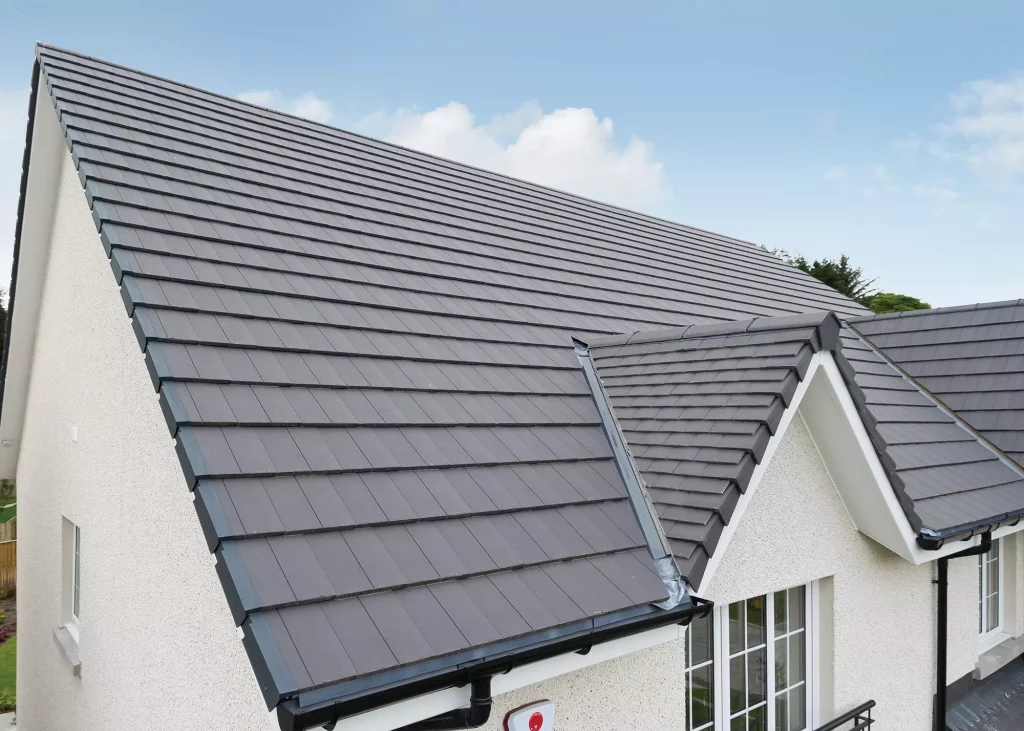
The roof of this house in Deeside, Scotland, is topped with concrete Marley Duo Edgemere tiles in smooth grey. This option was chosen due to its thin leading edge, which provides a cost-effective alternative to slate
“Clay has a proven history of longevity, and has been used for years as a material for building products,” says Richard Bishop, category marketing manager for roofing at Wienerberger.
“On the other hand, concrete can offer a clean and smooth finish due to the aggregate used in the mix. However, this process creates a ‘swiss cheese’ effect that’s visible when a concrete unit is viewed from its leading edge. It’s not present with clay versions as the material is cut.”
Read More: Choosing roof tiles for renovation projects
| QUICK GUIDE Clay Tile Types
Handmade roof tiles are individually made by artisan craftspeople, using moulds to achieve the desired shape and size. “The process means that every tile is slightly unique,” says Matthew Jenkins. Different surface textures can be applied before kiln-firing to achieve characterful finishes and variegations. “Since this is a detailed manufacturing process, these tiles come at a premium price,” says Matthew. Joe Lockhart suggests budgeting 50% more than for machine-made clay tiles. Handcrafted versions sit somewhere between handmade and machined. The initial manufacturing stage is carried out on an automated production line. This is where the tile is coloured and shaped accordingly. Before going into the kiln, the tiles are then hand-finished and individually checked. Machine-made roof tiles are, as the name suggests, completely factory-produced. “They are more uniform in their colour, shape, and style than other clay roof tiles, but can offer a contemporary appearance without compromising on the quality of the material,” says Matthew. Processes such as tumbling can add a traditional touch at a lower cost than hand-produced versions; but can’t fully recreate that authentic look. |
Tiled coverings are relatively heavy – so your home’s roof structure needs to be able to bear the weight. “Clay tiles typically weigh between 60-80kg per m2,” says roofer Joe Lockhart at Rated People.
“You won’t need a specialist roof structure as such, but it must be strong enough to withstand the load of the tiles. In some cases, that might mean a building has to have extra reinforcement.”
If you’re renovating a heritage property with existing clay tiles, and the timbers are in good condition, you can feel confident the structure is engineered to support a like-for-like replacement.
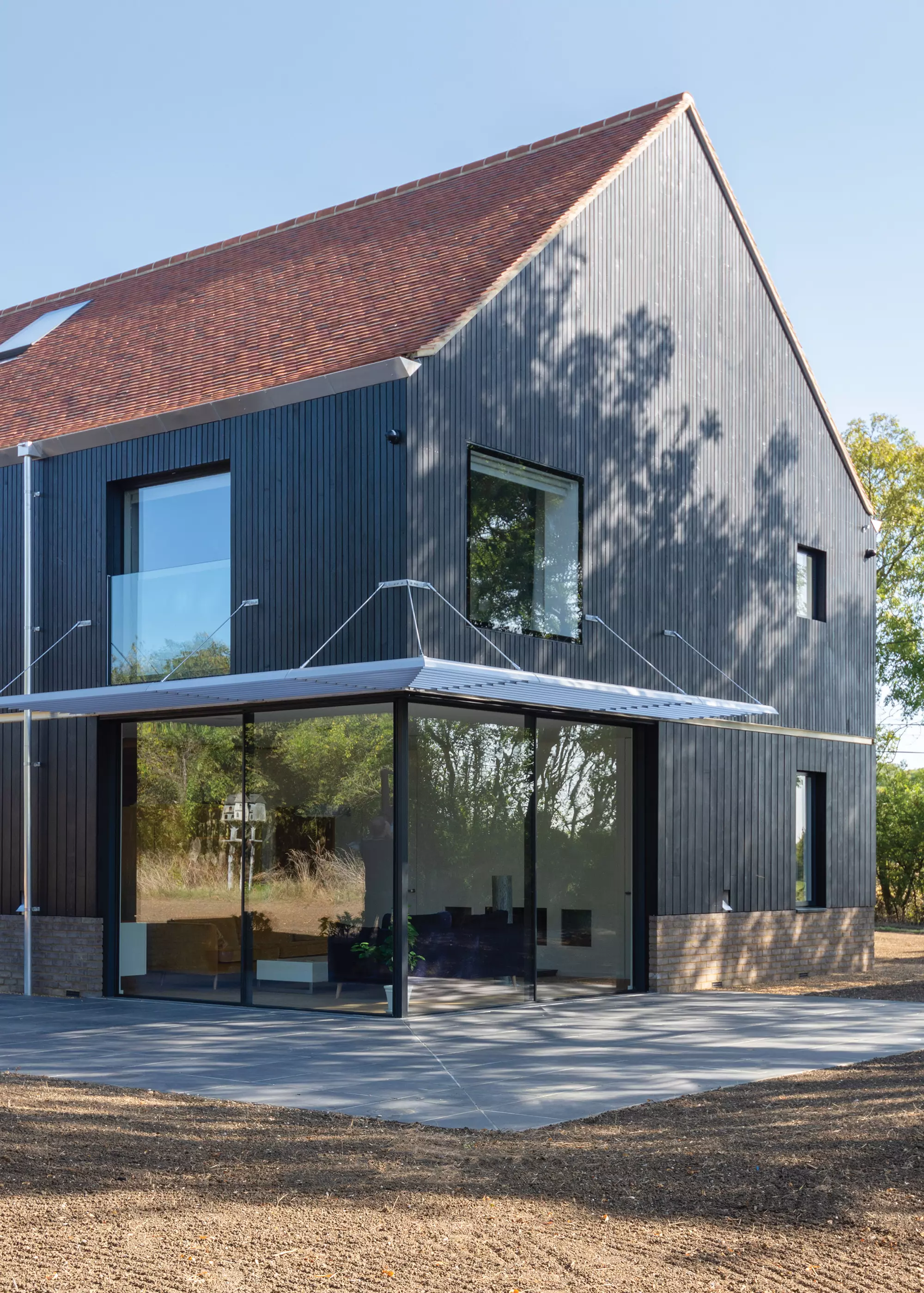
Weinerberger Goxhill plain clay tiles in dark red, autumn brown and dark chestnut were selected to cover this barn-style replacement house in Cambridge, designed by Ashworth Parkes Architects
Some types of concrete tile impose greater loads than others – and for typical UK installations, you can expect the covering to be heavier than a clay equivalent.
“Large-format interlocking concrete tiles tend to weigh around 40-60kg per m2, but concrete slates are more like 90-100kg per m2,” says Matthew Jenkins. “So, in most cases, an existing roof designed for clay will need to be reinforced to carry the load of heavy concrete tiles.”
A visual inspection by your builder or surveyor will determine what’s needed. “Reinforcing a roof is quite a straightforward process, and usually only represents a small portion of the total cost of retiling,” says Matthew.
Choosing between construction systems for your build? Read our guide to Contemporary Construction Systems
The location of your new build or renovation project may play an important role in the difficult choice between clay and concrete tiles.
Local planning guidelines often stipulate preferred roof coverings, materials and colour choices to be in keeping with the local vernacular. Although, it’s still possible to get creative when building new homes or extending an existing one.
Restrictions are likely to be even more pronounced if you’re building in an area of outstanding natural beauty, conservation area or working on or near a listed building.
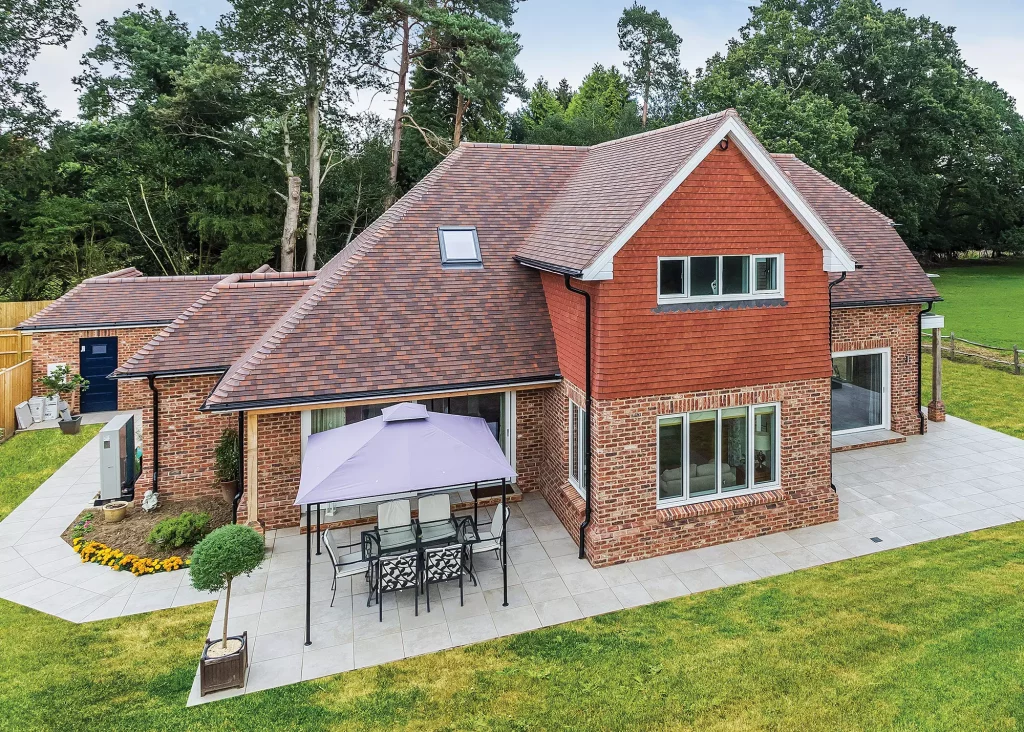
Clay tiles were chosen for the roof and some of the external cladding for this Scandia-Hus self build in West Sussex. Owners Jeanette and Ian Cooper picked Marley Hawkins Fired Sienna machine-made clay tiles because they’ve loved the mottled finish, which blends well with their chosen brick
“A lot of self-builders come to us because of planning constraints,” says David Osborn, director at Lifestiles. “In conservation areas and on listed buildings the planners often prefer you to use clay.” In some areas of the country, especially the south east, this material is intrinsically associated with the vernacular style.
If historical authenticity is critical, then only a handmade product will do – and achieving suitably subtle imperfections in texture, colour and size is certainly not possible with concrete.
“Handmade clay products support a traditional sector of the market and offer a unique finish you can’t achieve with a machine, although they are not right for every project,” says Richard Bishop.
Learn More: Complete Guide to Making a Successful Planning Application
“There’s no real performance gap between concrete and clay – they’re both going to keep the water out and last a long time – so it really comes down to aesthetics,” says David Osborn from Lifestles.
Manufacturers typically guarantee products for 30 years, but their full life cycle could easily be double that, depending on what kind of conditions the roof has been exposed to. It’s far more likely that what’s underneath will fail before the tiles do, the battens and underlay, for example.
Clay is more porous than concrete, and moss is more likely to grow on damp clay. You will, although, still get some moss and lichen on concrete.
This is not generally thought of as a problem unless it’s blocking gutters, and many people like the aesthetic of a moss-covered roof.
Clay tiles are more subject to damage in cold weather due to the cycle of freezing and thawing – hence they’re more prevalent in the south, where average temperatures are warmer. However, all products are tested to rigorous standards.
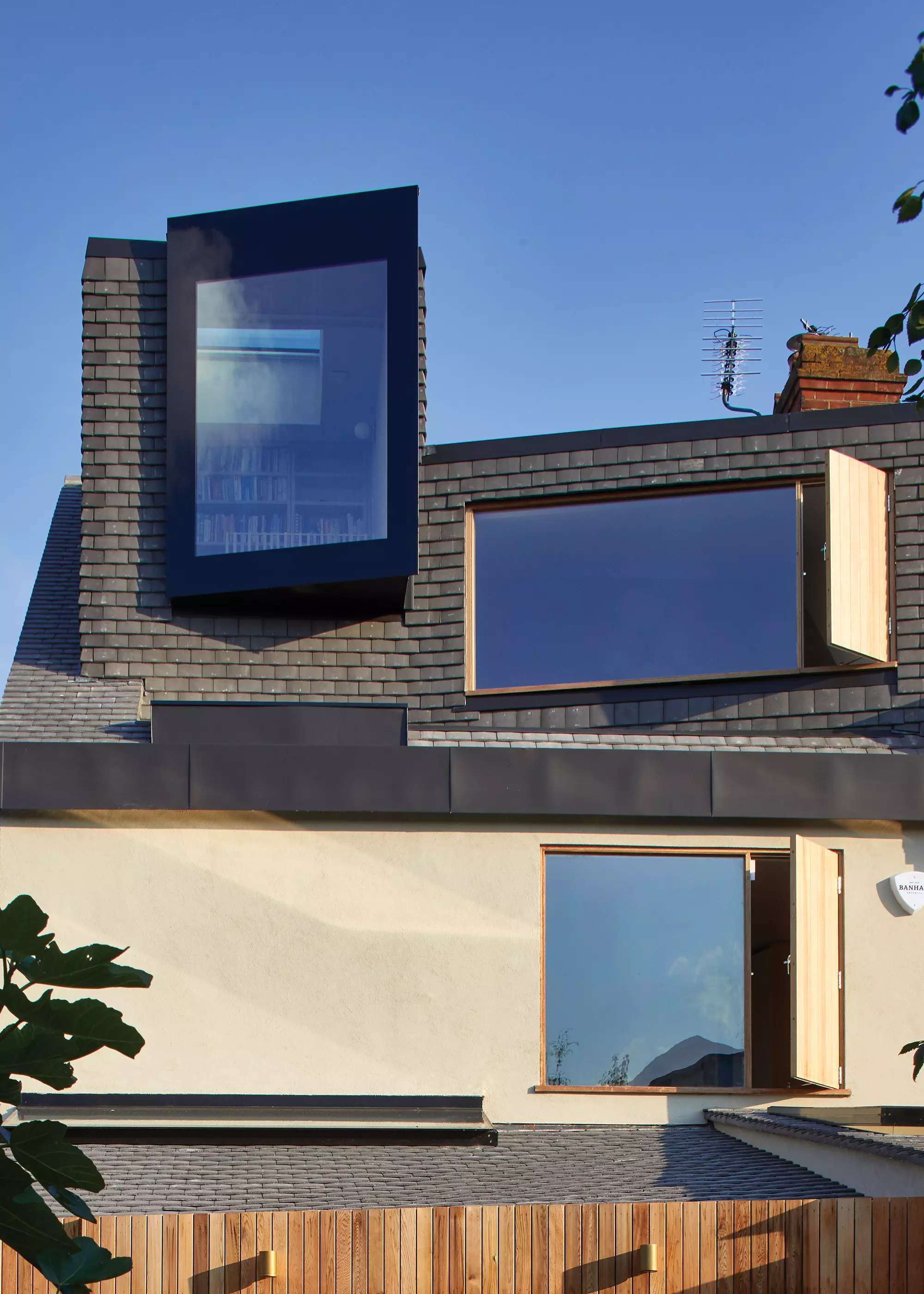
Local planning policy dictated the roofing material for this extension project in London by RISE Design Studio. It features Marley plain tiles in a smooth grey finish
Aaron at Heritage Clay Tiles has a further tip for self-builders and renovators: “If you tap on a clay tile and it sounds dull, like knocking on wood, then it’s been badly made and badly fired; but if it has a ring to it, that’s usually a sign of a good quality product.”
If you’re going for concrete tiles, for best results make sure they have been through-coloured rather than treated with something that has been applied to the surface. If your roof can take it, opt for heavy units, which should be less prone to breakage than lightweight options.
According to a recent survey by the National Custom and Self Build Association, NaCSBA, around 18% of self builders choose concrete roof tiles for their new homes. This was largely down to their affordability.
According to Matthew Jenkins, concrete roof tiles tend to cost around £10-£15 per m2 on average for the materials alone, whereas clay tiles can cost between £35-£40 per m2.
You’ll need to budget for battens, delivery, peripherals and installation on top of these figures – which will account for most of the total cost of a roofing project (especially if you’re going for a tile blend, which is usually mixed on site).

Oliver Leech Architects added creative flair to this hipped roof extension project in Epsom by sourcing grey tiles from Danish company Petersen Tegl. These make a statement in comparison to the traditional neighbouring red tiles. Photo: Ståle Eriksen
It’s important to look beyond upfront costs, though. “Clay is often seen as the better material,” says Matthew. “It offers better build quality, it’s stronger and is more durable, so clay roofs have a longer lifespan.” Their visual appeal can help to underpin the character of your home, too, potentially enhancing its value.
So, weigh up your requirements in terms of quality and how long you plan to stay in it. If you’re in a relatively modern house and don’t intend to stay for long, it may make more financial sense to go for concrete.
If this is your forever home, however, and you have the budget, investing in a clay roof covering might be a more sensible and cost-effective option in the long-run.
Looking for other roofing options? Read our Guide to Modern Roofing Materials
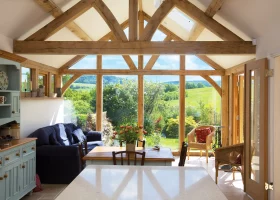

Comments are closed.